Lenovo L580, L480 User Manual
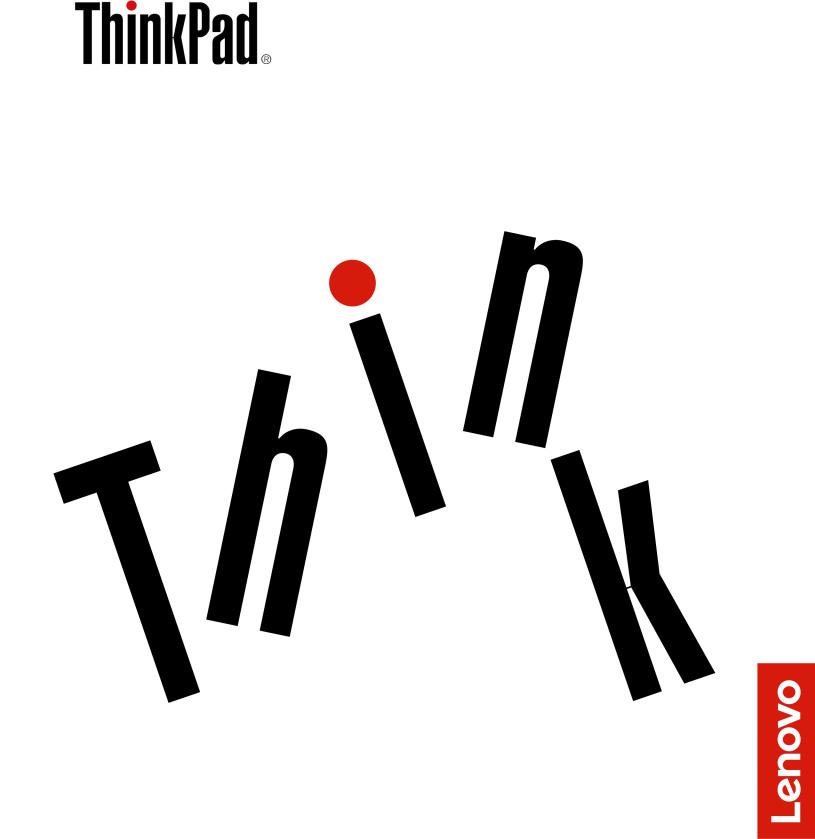
L480 and L580 User Guide
Note Before using this information and the product: it supports, ensure that you read and understand the following:
•Safety and Warranty Guide
•Setup Guide
•“Important safety information” on page v
Lenovo makes constant improvement on the documentation of your computer, including this User Guide To get all the latest documents, go to:
https://support.lenovo.com
Depending on the version of operating systems, some user interface instructions might not be applicable to your computer.
Fourth Edition (April 2019)
© Copyright Lenovo 2019.
LIMITED AND RESTRICTED RIGHTS NOTICE: If data or software is delivered pursuant to a General Services Administration “GSA” contract, use, reproduction, or disclosure is subject to restrictions set forth in Contract No. GS- 35F-05925.

Contents
Important safety information . . . . . . v
Read this first. . . . . . . . . . . . . . . |
. |
. |
v |
Important information about using your computer |
. |
. |
v |
Conditions that require immediate action . . . . . . vii
Service and upgrades . . . . . . . . . . . . |
viii |
Power cords and power adapters . . . . . . . . |
. ix |
Extension cords and related devices. . . . . . . |
. ix |
Plugs and outlets . . . . . . . . . . . . . . |
. x |
Power supply statement . . . . . . . . . . . |
. x |
External devices . . . . . . . . . . . . . . |
. xi |
General battery notice . . . . . . . . . . . . |
. xi |
Notice for built-in rechargeable battery. . . . . . |
. xi |
Notice for non-rechargeable coin-cell battery . . . |
. xii |
Heat and product ventilation . . . . . . . . . . |
xiii |
Electrical current safety information . . . . . . . |
xiv |
Liquid crystal display (LCD) notice . . . . . . . |
.xv |
Using headphones or earphones . . . . . . . . |
.xv |
Choking hazard notice . . . . . . . . . . . . |
.xv |
Plastic bag notice . . . . . . . . . . . . . . |
.xv |
Glass parts notice . . . . . . . . . . . . . . |
xvi |
Chapter 1. Product overview . . . |
. . |
. 1 |
|
Computer controls, connectors, and indicators |
. . |
. |
1 |
Front view (for ThinkPad L480 computers). |
. . |
. |
1 |
Front view (for ThinkPad L580 computers). |
. . |
. |
3 |
Left-side view . . . . . . . . . . . . . . . 5 Right-side view . . . . . . . . . . . . . . 7 Bottom view (for ThinkPad L480 computers) . . . 8 Bottom view (for ThinkPad L580 computers) . . . 8
Status indicators (for ThinkPad L480
computers) . . . . . . . . . . . . . . . . 9
Status indicators (for ThinkPad L580 |
|
computers) . . . . . . . . . . . . . . . |
10 |
Important product information . . . . . . . . . |
12 |
Machine type and model information. . . . . |
12 |
FCC ID and IC Certification information . . . . 13 |
|
Labels for the Windows operating systems . . |
13 |
Computer features. . . . . . . . . . . . . . |
14 |
Statement on USB transfer rate . . . . . . . . |
15 |
Computer specifications . . . . . . . . . . . |
15 |
Operating environment . . . . . . . . . . . . |
16 |
Lenovo programs . . . . . . . . . . . . . . |
16 |
Accessing Lenovo programs . . . . . . . . |
16 |
An introduction to Lenovo programs . . . . . |
16 |
Chapter 2. Using your computer . . . |
19 |
Registering your computer . . . . . . . . . . |
19 |
Frequently asked questions . . . . . . . . . . |
19 |
Using the multi-touch screen . . . . . . . . . |
20 |
Using the special keys (for ThinkPad L480 |
|
computers) . . . . . . . . . . . . . . . . |
22 |
Using the special keys (for ThinkPad L580 |
|
computers) . . . . . . . . . . . . . . . . |
24 |
Using the ThinkPad pointing device . . . . . . . |
26 |
ThinkPad pointing device overview . . . . . |
26 |
Using the TrackPoint pointing device. . . . . |
26 |
Using the trackpad . . . . . . . . . . . . |
27 |
Using the trackpad touch gestures . . . . . |
28 |
Customizing the ThinkPad pointing device . . |
29 |
Replacing the cap on the pointing stick . . . . 29 |
|
Power management . . . . . . . . . . . . . |
30 |
Using the ac power adapter . . . . . . . . |
30 |
Using the battery . . . . . . . . . . . . |
30 |
Managing the battery power . . . . . . . . |
32 |
Power-saving modes . . . . . . . . . . . |
32 |
Cabled Ethernet connections . . . . . . . . . |
32 |
Wireless connections . . . . . . . . . . . . |
33 |
Using the wireless-LAN connection . . . . . |
33 |
Using the wireless-WAN connection . . . . . |
33 |
Using the Bluetooth connection. . . . . . . |
34 |
Using the NFC devices . . . . . . . . . . |
34 |
Using the Airplane mode . . . . . . . . . |
36 |
Using audio features . . . . . . . . . . . . . |
36 |
Using the cameras. . . . . . . . . . . . . . |
36 |
Using a media card or a smart card . . . . . . . |
38 |
Using an external display . . . . . . . . . . . |
39 |
Traveling with your computer . . . . . . . . . |
41 |
Chapter 3. Enhancing your
computer. . . . . . . . . . . . . . . . 43
Finding ThinkPad options . . . . . . . . . . . |
43 |
ThinkPad Basic Docking Station, ThinkPad Pro |
|
Docking Station, and ThinkPad Ultra Docking |
|
Station . . . . . . . . . . . . . . . . . . |
43 |
Locating controls, connectors, and |
|
indicators . . . . . . . . . . . . . . . |
43 |
Attaching your computer to a docking |
|
station . . . . . . . . . . . . . . . . |
45 |
Detaching your computer from a docking |
|
station . . . . . . . . . . . . . . . . |
47 |
Guidelines on connecting multiple external |
|
displays . . . . . . . . . . . . . . . . |
48 |
Chapter 4. Accessibility, ergonomic, |
|
and maintenance information . . . . . |
51 |
© Copyright Lenovo 2019 |
i |
Accessibility information . . . . . . . . . . . |
51 |
Ergonomic information . . . . . . . . . . . . |
53 |
Cleaning and maintenance . . . . . . . . . . |
54 |
Chapter 5. Security . . . . . . . . . . 57
Using passwords . . . . . . . . . . . . . . |
57 |
Passwords introduction . . . . . . . . . . |
57 |
Setting, changing, or removing a password . . |
58 |
Hard disk security . . . . . . . . . . . . . . |
59 |
Setting the security chip . . . . . . . . . . . |
60 |
Using the fingerprint reader . . . . . . . . . . |
60 |
Deleting data from your storage drive . . . . . . |
62 |
Using firewalls . . . . . . . . . . . . . . . |
62 |
Protecting data against viruses . . . . . . . . . |
63 |
Chapter 6. Advanced
configuration . . . . . . . . . . . . . . 65
Installing a Windows 10 operating system . . . . |
65 |
Installing device drivers . . . . . . . . . . . . |
66 |
Using the ThinkPad Setup program . . . . . . . |
67 |
Configuring ThinkPad Setup . . . . . . . . |
67 |
Changing the startup sequence . . . . . . . |
67 |
Updating the UEFI BIOS. . . . . . . . . . |
68 |
BIOS menu . . . . . . . . . . . . . . . |
68 |
Using system management . . . . . . . . . . |
78 |
Chapter 7. Troubleshooting
computer problems . . . . . . . . . . 81
General tips for preventing problems . . . . . . |
81 |
Diagnosing problems . . . . . . . . . . . . |
81 |
Troubleshooting . . . . . . . . . . . . . . |
82 |
Computer stops responding . . . . . . . . |
82 |
Spills on the keyboard . . . . . . . . . . |
82 |
Error messages . . . . . . . . . . . . . |
83 |
Beep errors. . . . . . . . . . . . . . . |
84 |
Memory module problems . . . . . . . . . |
86 |
Ethernet problems . . . . . . . . . . . . |
86 |
Wireless-LAN problem . . . . . . . . . . |
87 |
Wireless-WAN problem . . . . . . . . . . |
87 |
Bluetooth problem . . . . . . . . . . . . |
88 |
ThinkPad pointing device problems . . . . . |
88 |
Keyboard problems . . . . . . . . . . . |
88 |
Computer screen problems . . . . . . . . |
89 |
External monitor problems . . . . . . . . . |
91 |
Audio problems . . . . . . . . . . . . . |
92 |
Fingerprint reader problems . . . . . . . . |
93 |
Battery problems . . . . . . . . . . . . |
93 |
ac power adapter problem . . . . . . . . . |
94 |
Power problems . . . . . . . . . . . . . |
94 |
Power button problem . . . . . . . . . . |
95 |
Boot problems . . . . . . . . . . . . . |
95 |
Sleep and hibernation problems . . . . . . |
95 |
Hard disk drive problems . . . . . . . . . |
96 |
Solid-state drive problem . . . . . . . . . |
96 |
ThinkPad Pen Pro problem . . . . . . . . |
96 |
Software problem . . . . . . . . . . . . |
97 |
USB problem . . . . . . . . . . . . . . |
97 |
Docking station problem . . . . . . . . . |
97 |
Chapter 8. Recovery information . . . |
99 |
Resetting your computer . . . . . . . . . . . |
99 |
Using advanced startup options . . . . . . . . |
99 |
Recovering your operating system if Windows 10 |
|
fails to start . . . . . . . . . . . . . . . . |
99 |
Creating and using a recovery USB drive . . . . . |
100 |
Chapter 9. Replacing devices . . . . |
.101 |
|
Customer Replaceable Units. . . . . . . . . |
. |
101 |
Static electricity prevention . . . . . . . . . |
. |
101 |
Disabling the built-in battery . . . . . . . . . |
. |
102 |
Replacing the nano-SIM card . . . . . . . . |
. |
102 |
Replacing the microSD card . . . . . . . . . |
. |
103 |
Replacing the base cover assembly . . . . . . |
. |
104 |
Replacing the wireless-WAN card. . . . . . . |
. |
106 |
Replacing the memory module . . . . . . . . |
. |
108 |
Replacing the internal storage drive . . . . . . |
. |
110 |
Replacing the M.2 solid-state drive in the wireless- WAN-card slot . . . . . . . . . . . . . . . 117
Replacing the USB/Audio card (for ThinkPad L480 computers) . . . . . . . . . . . . . . . . 119
Replacing the speaker assembly (for ThinkPad |
|
|
|||||
L480 computers) . . . . . |
. . |
. |
. |
. . |
. . |
. |
120 |
Replacing the speaker assembly (for ThinkPad |
|
|
|||||
L580 computers) . . . . . |
. . |
. |
. |
. . |
. . |
. |
122 |
Replacing the keyboard. . . . . . . . . . . . 124
Chapter 10. Getting support. |
. . . . .131 |
Before you contact Lenovo . . . . . |
. . . . . 131 |
Getting help and service . . . . . . |
. . . . . 131 |
Lenovo Support Web site . . . . |
. . . . . 132 |
Calling Lenovo . . . . . . . . |
. . . . . 132 |
Purchasing additional services . . . . |
. . . . . 133 |
Appendix A. Supplemental
information about the Ubuntu operating system . . . . . . . . . . . . . . . . .135
Appendix B. Regulatory
information . . . . . . . . . . . . . . .137
Appendix C. WEEE and recycling statements of countries and
regions . . . . . . . . . . . . . . . . .143
ii L480 and L580 User Guide

Appendix D. Restriction of Hazardous |
Appendix F. Notices . . . . . . . . . .153 |
Substances (RoHS) Directive of countries |
Appendix G. Trademarks . . . . . . .155 |
and regions. . . . . . . . . . . . . . .147 |
|
Appendix E. ENERGY STAR model |
|
information . . . . . . . . . . . . . . .151 |
|
© Copyright Lenovo 2019 |
iii |
iv L480 and L580 User Guide

Important safety information
Note: Read the important safety information first.
Read this first
This information can help you safely use your notebook computer. Follow and retain all information included with your computer. The information in this document does not alter the terms of your purchase agreement or the Limited Warranty. For more information, see "Warranty Information" in the Safety and Warranty Guide that comes with your computer.
Customer safety is important. Our products are developed to be safe and effective. However, personal computers are electronic devices. Power cords, power adapters, and other features can create potential safety risks that can result in physical injury or property damage, especially if misused. To reduce these risks, follow the instructions included with your product, observe all warnings on the product and in the operating instructions, and review the information included in this document carefully. By carefully following the information contained in this document and provided with your product, you can help protect yourself from hazards and create a safer computer work environment.
Note: This information includes references to power adapters and batteries. In addition to notebook computers, some products (such as speakers and monitors) ship with external power adapters. If you have such a product, this information applies to your product. In addition, computer products contain a coin-sized internal battery that provides power to the system clock even when the computer is unplugged, so the battery safety information applies to all computer products.
Important information about using your computer
Ensure that you follow the important tips given here to get the most use and enjoyment out of your computer. Failure to do so might lead to discomfort or injury, or cause the computer to fail.
Protect yourself from the heat that your computer generates.
When your computer is turned on or the battery is charging, the base, the palm rest, and some other parts may become hot. The temperature they reach depends on the amount of system activity and the level of charge in the battery.
Extended contact with your body, even through clothing, could cause discomfort or even a skin burn.
•Avoid keeping your hands, your lap, or any other part of your body in contact with a hot section of the computer for any extended time.
•Periodically take hands from using the keyboard by lifting your hands from the palm rest.
© Copyright Lenovo 2019 |
v |
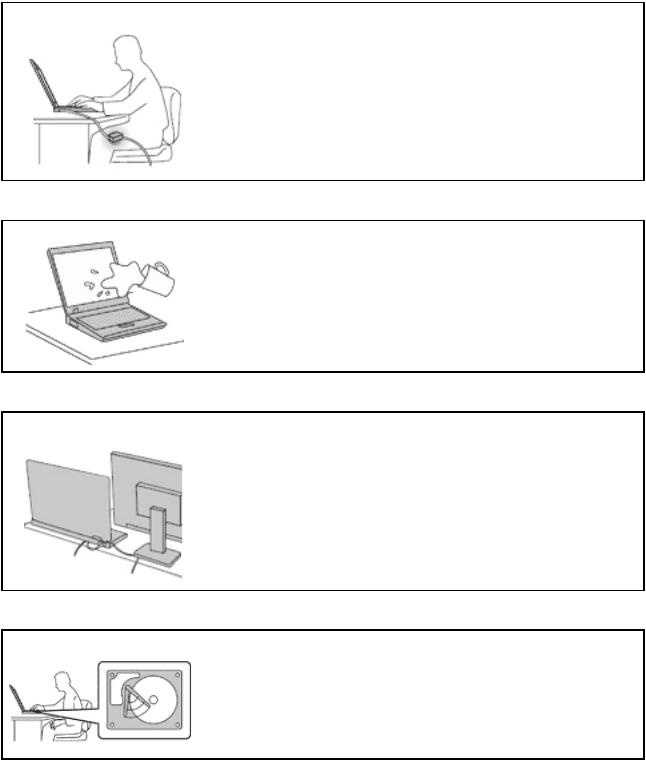
Protect yourself from the heat generated by the ac power adapter.
When the ac power adapter is connected to an electrical outlet and your computer, it generates heat.
Extended contact with your body, even through clothing, may cause a skin burn.
•Do not place the ac power adapter in contact with any part of your body while it is in use.
•Never use it to warm your body.
•Do not wrap the cords around the ac power adapter while in use.
Prevent your computer from getting wet.
To avoid spills and the danger of electrical shock, keep liquids away from your computer.
Protect the cables from being damaged.
Applying strong force to cables may damage or break them.
Route communication lines, or the cables of an ac power adapter, a mouse, a keyboard, a printer, or any other electronic device, so that they cannot be walked on, tripped over, pinched by your computer or other objects, or in any way subject to treatment that could interfere with the operation of your computer.
Protect your computer and data when moving it.
Before moving a computer equipped with a hard disk drive, do one of the following:
•Turn it off.
•Put it in sleep mode.
•Put it in hibernation mode.
This helps to prevent damage to the computer, and possible loss of data.
vi L480 and L580 User Guide
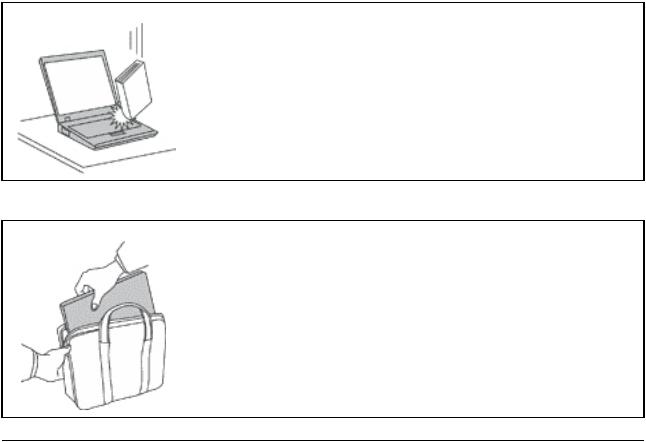
Handle your computer gently.
Do not drop, bump, scratch, twist, hit, vibrate, push, or place heavy objects on your computer, display, or external devices.
Carry your computer carefully.
•Use a quality carrying case that provides adequate cushioning and protection.
•Do not pack your computer in a tightly packed suitcase or bag.
•Before putting your computer in a carrying case, make sure that it is off, in sleep mode, or in hibernation mode. Do not put a computer in a carrying case while it is turned on.
Conditions that require immediate action
Products can become damaged due to misuse or neglect. Some product damage is serious enough that the product should not be used again until it has been inspected and, if necessary, repaired by an authorized servicer.
As with any electronic device, pay close attention to the product when it is turned on. On very rare occasions, you might notice an odor or see a puff of smoke or sparks vent from your product. Or you might hear sounds like popping, cracking, or hissing. These conditions might merely mean that an internal electronic component has failed in a safe and controlled manner. Or, they might indicate a potential safety issue. However, do not take risks or attempt to diagnose the situation yourself. Contact the Customer Support Center for further guidance. For a list of Service and Support phone numbers, see the following Web site:
https://pcsupport.lenovo.com/supportphonelist
Frequently inspect your computer and its components for damage or wear or signs of danger. If you have any question about the condition of a component, do not use the product. Contact the Customer Support Center or the product manufacturer for instructions on how to inspect the product and have it repaired, if necessary.
In the unlikely event that you notice any of the following conditions, or if you have any safety concerns with your product, stop using the product and unplug it from the power source and telecommunication lines until you can speak to the Customer Support Center for further guidance.
© Copyright Lenovo 2019 |
vii |
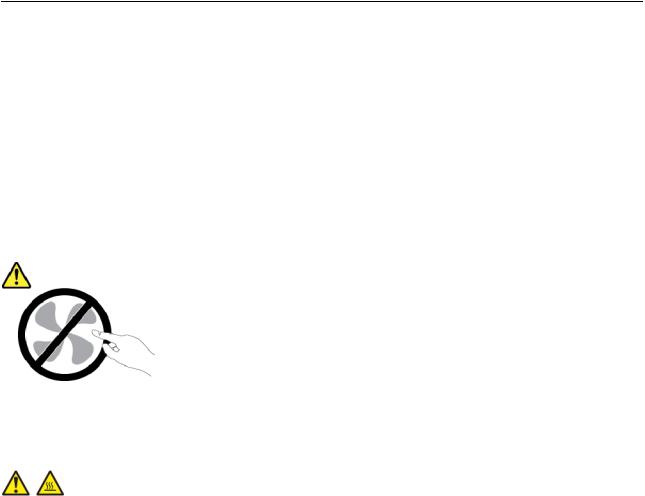
•Power cords, plugs, power adapters, extension cords, surge protectors, or power supplies that are cracked, broken, or damaged.
•Signs of overheating, smoke, sparks, or fire.
•Damage to a battery (such as cracks, dents, or creases), discharge from a battery, or a buildup of foreign substances on the battery.
•A cracking, hissing, or popping sound, or strong odor that comes from the product.
•Signs that liquid has been spilled or an object has fallen onto the computer product, the power cord, or power adapter.
•The computer product, power cord, or power adapter has been exposed to water.
•The product has been dropped or damaged in any way.
•The product does not operate normally when you follow the operating instructions.
Note: If you notice these conditions with a product (such as an extension cord) that is not manufactured for or by Lenovo®, stop using that product until you can contact the product manufacturer for further instructions, or until you get a suitable replacement.
Service and upgrades
Do not attempt to service a product yourself unless instructed to do so by the Customer Support Center or your documentation. Only use a Service Provider who is approved to repair your particular product.
Note: Some computer parts can be upgraded or replaced by the customer. Upgrades typically are referred to as options. Replacement parts approved for customer installation are referred to as Customer Replaceable Units, or CRUs. Lenovo provides documentation with instructions when it is appropriate for customers to install options or replace CRUs. You must closely follow all instructions when installing or replacing parts. The Off state of a power indicator does not necessarily mean that voltage levels inside a product are zero. Before you remove the covers from a product equipped with a power cord, always make sure that the power is turned off and that the product is unplugged from any power source. If you have any questions or concerns, contact the Customer Support Center.
Although there are no moving parts in your computer after the power cord has been disconnected, the following warnings are required for your safety.
CAUTION:
Hazardous moving parts. Keep fingers and other body parts away.
CAUTION:
Before you open the computer cover, turn off the computer and wait several minutes until the computer is cool.
viii L480 and L580 User Guide

Power cords and power adapters
 DANGER
DANGER
Use only the power cords and power adapters supplied by the product manufacturer.
The power cords shall be safety approved. For Germany, it shall be H03VV-F, 3G, 0.75 mm2, or better. For other countries, the suitable types shall be used accordingly.
Never wrap a power cord around a power adapter or other object. Doing so can stress the cord in ways that can cause the cord to fray, crack, or crimp. This can present a safety hazard.
Always route power cords so that they will not be walked on, tripped over, or pinched by objects.
Protect power cords and power adapters from liquids. For instance, do not leave your power cord or power adapter near sinks, tubs, toilets, or on floors that are cleaned with liquid cleansers. Liquids can cause a short circuit, particularly if the power cord or power adapter has been stressed by misuse. Liquids also can cause gradual corrosion of power cord terminals and/or the connector terminals on a power adapter, which can eventually result in overheating.
Ensure that all power cord connectors are securely and completely plugged into receptacles.
Do not use any power adapter that shows corrosion at the ac input pins or shows signs of overheating (such as deformed plastic) at the ac input pins or anywhere on the power adapter.
Do not use any power cords where the electrical contacts on either end show signs of corrosion or overheating or where the power cord appears to have been damaged in any way.
To prevent possible overheating, do not cover the power adapter with clothing or other objects when the power adapter is plugged into an electrical outlet.
Extension cords and related devices
Ensure that extension cords, surge protectors, uninterruptible power supplies, and power strips that you use are rated to handle the electrical requirements of the product. Never overload these devices. If power strips are used, the load should not exceed the power strip input rating. Consult an electrician for more information if you have questions about power loads, power requirements, and input ratings.
© Copyright Lenovo 2019 |
ix |
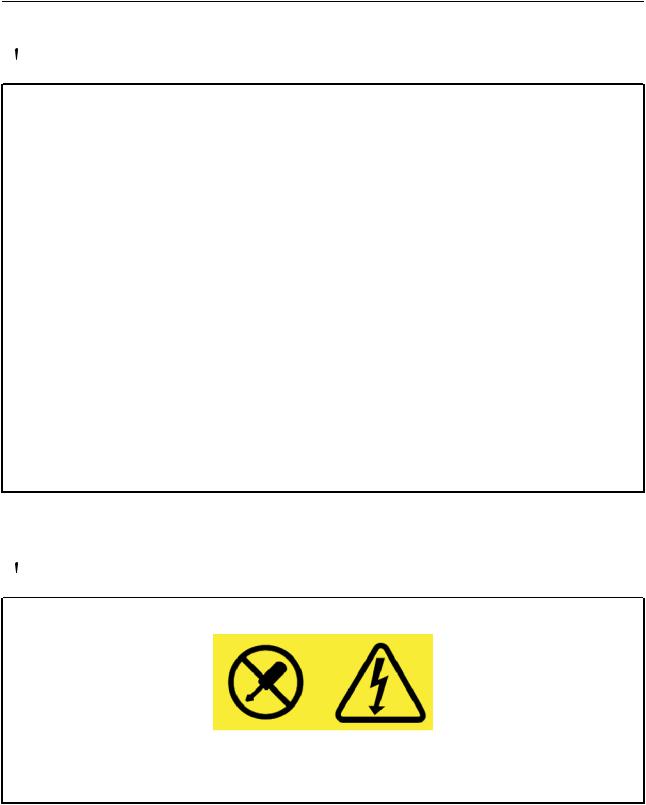
Plugs and outlets
 DANGER
DANGER
If a receptacle (power outlet) that you intend to use with your computer equipment appears to be damaged or corroded, do not use the outlet until it is replaced by a qualified electrician.
Do not bend or modify the plug. If the plug is damaged, contact the manufacturer to obtain a replacement.
Do not share an electrical outlet with other home or commercial appliances that draw large amounts of electricity; otherwise, unstable voltage might damage your computer, data, or attached devices.
Some products are equipped with a three-pronged plug. This plug fits only into a grounded electrical outlet. This is a safety feature. Do not defeat this safety feature by trying to insert it into a non-grounded outlet. If you cannot insert the plug into the outlet, contact an electrician for an approved outlet adapter or to replace the outlet with one that enables this safety feature. Never overload an electrical outlet. The overall system load should not exceed 80 percent of the branch circuit rating. Consult an electrician for more information if you have questions about power loads and branch circuit ratings.
Be sure that the power outlet you are using is properly wired, easily accessible, and located close to the equipment. Do not fully extend power cords in a way that will stress the cords.
Be sure that the power outlet provides the correct voltage and current for the product you are installing.
Carefully connect and disconnect the equipment from the electrical outlet.
Power supply statement
 DANGER
DANGER
Never remove the cover on a power supply or any part that has the following label attached.
Hazardous voltage, current, and energy levels are present inside any component that has this label attached. There are no serviceable parts inside these components. If you suspect a problem with one of these parts, contact a service technician.
x L480 and L580 User Guide

External devices
CAUTION:
Do not connect or disconnect any external device cables other than Universal Serial Bus (USB) and 1394 cables while the computer power is on; otherwise, you might damage your computer. To avoid possible damage to attached devices, wait at least five seconds after the computer is shut down to disconnect external devices.
General battery notice
 DANGER
DANGER
Batteries supplied by Lenovo for use with your product have been tested for compatibility and should only be replaced with approved parts. A battery other than the one specified by Lenovo, or a disassembled or modified battery is not covered by the warranty.
Battery abuse or mishandling can cause overheat, liquid leakage, or an explosion. To avoid possible injury, do the following:
•Do not open, dissemble, or service any battery.
•Do not crush or puncture the battery.
•Do not short-circuit the battery, or expose it to water or other liquids.
•Keep the battery away from children.
•Keep the battery away from fire.
Stop using the battery if it is damaged, or if you notice any discharge or the buildup of foreign materials on the battery leads.
Store the rechargeable batteries or products containing the rechargeable batteries at room temperature, charged to approximately 30 to 50% of capacity. We recommend that the batteries be charged about once per year to prevent overdischarge.
Do not put the battery in trash that is disposed of in landfills. When disposing of the battery, comply with local ordinances or regulations.
Notice for built-in rechargeable battery
 DANGER
DANGER
Do not attempt to remove or replace the built-in rechargeable battery. Replacement of the battery must be done by a Lenovo-authorized repair facility or technician.
Only recharge the battery strictly according to instructions included in the product documentation.
The Lenovo-authorized repair facilities or technicians recycle Lenovo batteries according to local laws and regulations.
© Copyright Lenovo 2019 |
xi |

Notice for non-rechargeable coin-cell battery
 DANGER
DANGER
Do not attempt to replace the non-rechargeable coin-cell battery. Replacement of the battery must be done by a Lenovo-authorized repair facility or technician.
The Lenovo-authorized repair facilities or technicians recycle Lenovo batteries according to local laws and regulations.
The following statement applies to users in the state of California, U.S.A.
California Perchlorate Information:
Products containing manganese dioxide lithium coin-cell batteries may contain perchlorate.
Perchlorate Material - special handling may apply, See https://www.dtsc.ca.gov/hazardouswaste/ perchlorate/
xii L480 and L580 User Guide
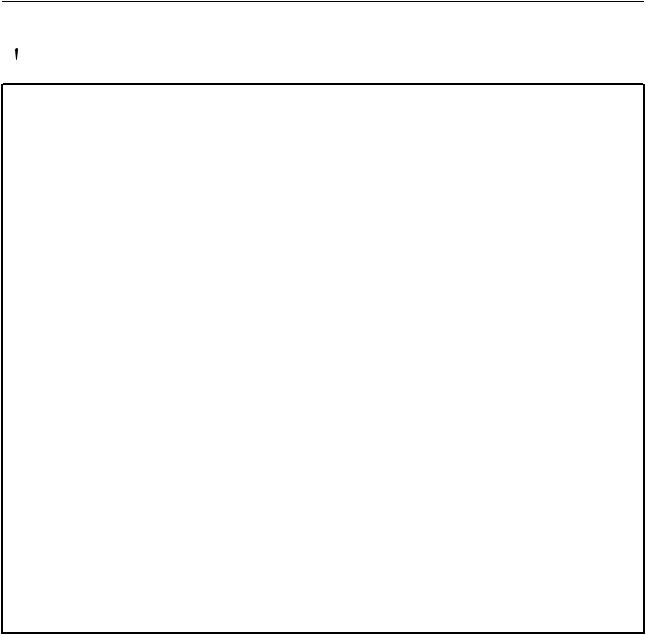
Heat and product ventilation
 DANGER
DANGER
Computers, ac power adapters, and many accessories can generate heat when turned on and when batteries are charging. Notebook computers can generate a significant amount of heat due to their compact size. Always follow these basic precautions:
•When your computer is turned on or the battery is charging, the base, the palm rest, and some other parts may become hot. Avoid keeping your hands, your lap, or any other part of your body in contact with a hot section of the computer for any extended length of time. When you use the keyboard, avoid keeping your palms on the palm rest for a prolonged period of time. Your computer generates some heat during normal operation. The amount of heat depends on the amount of system activity and the battery charge level. Extended contact with your body, even through clothing, could cause discomfort or even a skin burn. Periodically take breaks from using the keyboard by lifting your hands from the palm rest; and be careful not to use the keyboard for any extended length of time.
•Do not operate your computer or charge the battery near flammable materials or in explosive environments.
•Ventilation slots, fans and/or heat sinks are provided with the product for safety, comfort, and reliable operation. These features might inadvertently become blocked by placing the product on a bed, sofa, carpet, or other flexible surface. Never block, cover, or disable these features.
•When the ac power adapter is connected to an electrical outlet and your computer, it generates heat. Do not place the adapter in contact with any part of your body while using it. Never use the ac power adapter to warm your body. Extended contact with your body, even through clothing, may cause a skin burn.
For your safety, always follow these basic precautions with your computer:
•Keep the cover closed whenever the computer is plugged in.
•Regularly inspect the outside of the computer for dust accumulation.
•Remove dust from vents and any perforations in the bezel. More frequent cleanings might be required for computers in dusty or high-traffic areas.
•Do not restrict or block any ventilation openings.
•Do not operate your computer inside furniture, as this might increase the risk of overheating.
•Airflow temperatures into the computer should not exceed 35°C (95°F).
© Copyright Lenovo 2019 |
xiii |

Electrical current safety information
 DANGER
DANGER
Electric current from power, telephone, and communication cables is hazardous.
To avoid a shock hazard:
•Do not use your computer during a lightning storm.
•Do not connect or disconnect any cables or perform installation, maintenance, or reconfiguration of this product during an electrical storm.
•Connect all power cords to a properly wired and grounded electrical outlet.
•Connect to properly wired outlets any equipment that will be attached to this product.
•Whenever possible, use one hand only to connect or disconnect signal cables.
•Never turn on any equipment when there is evidence of fire, water, or structural damage.
•Disconnect the attached power cords, battery, and all the cables before you open the device covers, unless instructed otherwise in the installation and configuration procedures.
•Do not use your computer until all internal parts enclosures are fastened into place. Never use the computer when internal parts and circuits are exposed.
 DANGER
DANGER
Connect and disconnect cables as described in the following procedures when installing, moving, or opening covers on this product or attached devices.
To connect:
1.Turn everything OFF.
2.First, attach all cables to devices.
3.Attach signal cables to connectors.
4.Attach power cords to outlets.
5.Turn devices ON.
To disconnect:
1.Turn everything OFF.
2.First, remove power cords from outlets.
3.Remove signal cables from connectors.
4.Remove all cables from devices.
The power cord must be disconnected from the wall outlet or receptacle before installing all other electrical cables connected to the computer.
The power cord may be reconnected to the wall outlet or receptacle only after all other electrical cables have been connected to the computer.
 DANGER
DANGER
During electrical storms, do not perform any replacement and do not connect the telephone cable to or disconnect it from the telephone outlet on the wall.
xiv L480 and L580 User Guide
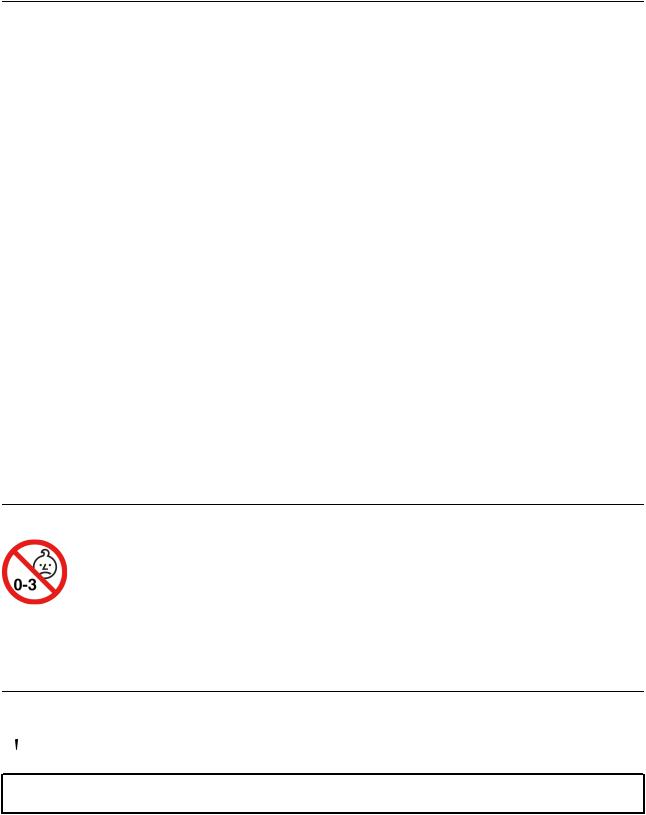
Liquid crystal display (LCD) notice
CAUTION:
The liquid crystal display (LCD) is made of glass, and rough handling or dropping the computer can cause the LCD to break. If the LCD breaks and the internal fluid gets into your eyes or on your hands, immediately wash the affected areas with water for at least 15 minutes; if any symptoms are present after washing, get medical care.
Note: For products with mercury-containing fluorescent lamps (for example, non-LED), the fluorescent lamp in the liquid crystal display (LCD) contains mercury; dispose of according to local, state, or federal laws.
Using headphones or earphones
CAUTION:
Excessive sound pressure from earphones and headphones can cause hearing loss. Adjustment of the equalizer to maximum increases the earphone and headphone output voltage and the sound pressure level. Therefore, to protect your hearing, adjust the equalizer to an appropriate level.
Excessive use of headphones or earphones for a long period of time at high volume can be dangerous if the output of the headphone or earphone connectors do not comply with specifications of EN 50332-2. The headphone output connector of your computer complies with EN 50332-2 Sub clause 7. This specification limits the computer’s maximum wide band true RMS output voltage to 150 mV. To help protect against hearing loss, ensure that the headphones or earphones you use also comply with EN 50332-2 (Clause 7 limits) for a wide band characteristic voltage of 75 mV. Using headphones that do not comply with EN 50332- 2 can be dangerous due to excessive sound pressure levels.
If your Lenovo computer came with headphones or earphones in the package, as a set, the combination of the headphones or earphones and the computer already complies with the specifications of EN 50332-1. If different headphones or earphones are used, ensure that they comply with EN 50332-1 (Clause 6.5 Limitation Values). Using headphones that do not comply with EN 50332-1 can be dangerous due to excessive sound pressure levels.
Choking hazard notice
CHOKING HAZARD – Product contains small parts.
Keep away from children under three years.
Plastic bag notice
 DANGER
DANGER
Plastic bags can be dangerous. Keep plastic bags away from babies and children to avoid danger of suffocation.
© Copyright Lenovo 2019 |
xv |

Glass parts notice
CAUTION:
Some parts of your product may be made of glass. This glass could break if the product is dropped on a hard surface or receives a substantial impact. If glass breaks, do not touch or attempt to remove it. Stop using your product until the glass is replaced by trained service personnel.
xvi L480 and L580 User Guide
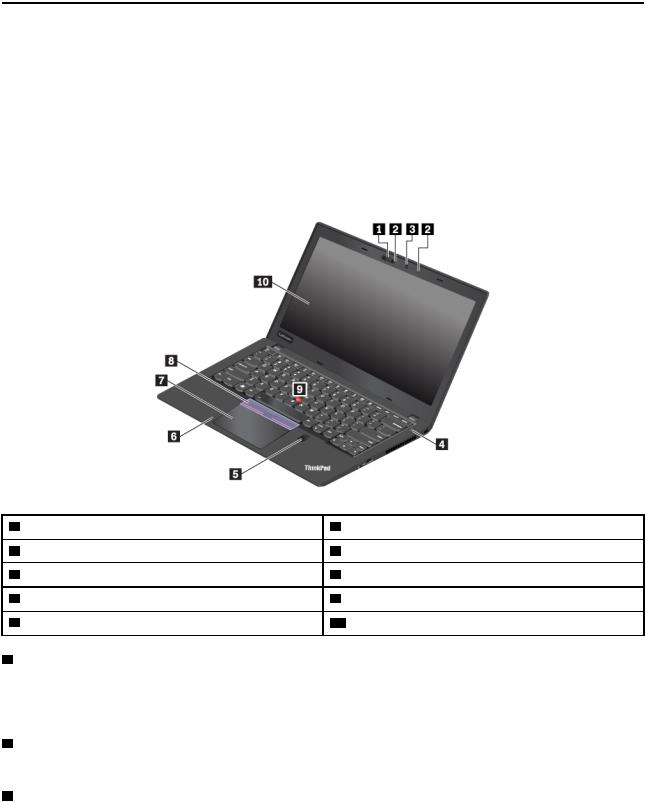
Chapter 1. Product overview
This chapter provides basic information to help you get familiar with your computer.
Computer controls, connectors, and indicators
This section introduces hardware features of the computer.
Front view (for ThinkPad L480 computers)
1 |
Infrared camera (available on some models) |
2 |
Microphones |
3 |
Conventional camera |
4 |
Power button |
5 |
Fingerprint reader (available on some models) |
6 |
NFC mark (available on some models) |
7 |
Trackpad |
8 |
TrackPoint® buttons |
9 |
TrackPoint pointing stick |
10 Multi-touch screen (available on some models) |
|
1 Infrared camera (available on some models)
The infrared camera provides a personal and secure way for you to sign in to your computer with face authentication. After setting the infrared camera for face authentication, you can unlock your computer by scanning your face instead of using a password. For more information, see “Using the cameras” on page 36.
2 Microphones
The microphones capture sound and voice when used with a program capable of handling audio.
3 Conventional camera
The camera enables you to take pictures or hold a video conference. For more information, see “Using the cameras” on page 36.
© Copyright Lenovo 2019 |
1 |

4 Power button
Press the power button to turn on the computer or put the computer into sleep mode.
To turn off the computer, open the Start menu and click  Power and then click Shut down
Power and then click Shut down
If your computer is unresponsive, you can turn off the computer by pressing and holding the power button for four or more seconds. If the computer cannot be turned off, see “Computer stops responding” on page 82 for more information.
You also can define what the power button does. For example, by pressing the power button, you can turn off the computer or put the computer into sleep or hibernation mode. To change what the power button does, do the following:
1.Go to Control Panel, and then change the view of Control Panel from Category to Large icons or Small icons.
2. Click Power Options Choose what the power buttons do |
. |
3. Follow the instructions on the screen.
5 Fingerprint reader (available on some models)
Fingerprint authentication provides simple and secure user access by associating your fingerprint with a password. For more information, see “Using the fingerprint reader” on page 60.
6 NFC mark (available on some models)
Near field communication (NFC) is a high-frequency and short-range wireless communication technology. By using NFC, you can establish radio communications between your computer and another NFC-enabled device over a few centimeters or inches. For more information, see “Using the NFC devices” on page 34.
ThinkPad pointing device
7Trackpad
8TrackPoint buttons
9TrackPoint pointing stick
Your computer is equipped with the Lenovo-unique ThinkPad® pointing device. For more information, see “Using the ThinkPad pointing device” on page 26.
10 Multi-touch screen (available on some models)
The multi-touch screen enables you to use your computer with simple touch gestures. For more information, see “Using the multi-touch screen” on page 20.
2 L480 and L580 User Guide
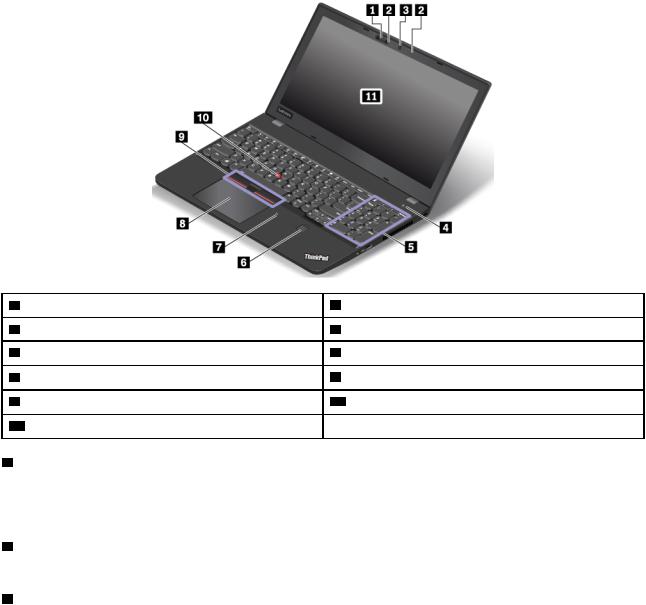
Front view (for ThinkPad L580 computers)
1 |
Infrared camera (available on some models) |
2 |
Microphones |
3 |
Conventional camera |
4 |
Power button |
5 |
Numeric keypad |
6 |
Fingerprint reader (available on some models) |
7 |
NFC mark (available on some models) |
8 |
Trackpad |
9 |
TrackPoint buttons |
10 TrackPoint pointing stick |
|
11 Multi-touch screen (available on some models)
1 Infrared camera (available on some models)
The infrared camera provides a personal and secure way for you to sign in to your computer with face authentication. After setting the infrared camera for face authentication, you can unlock your computer by scanning your face instead of using a password. For more information, see “Using the cameras” on page 36.
2 Microphones
The microphones capture sound and voice when used with a program capable of handling audio.
3 Conventional camera
The camera enables you to take pictures or hold a video conference. For more information, see “Using the cameras” on page 36.
Chapter 1. Product overview 3

4 Power button
Press the power button to turn on the computer or put the computer into sleep mode.
To turn off the computer, open the Start menu and click  Power and then click Shut down
Power and then click Shut down
If your computer is unresponsive, you can turn off the computer by pressing and holding the power button for four or more seconds. If the computer cannot be turned off, see “Computer stops responding” on page 82 for more information.
You also can define what the power button does. For example, by pressing the power button, you can turn off the computer or put the computer into sleep or hibernation mode. To change what the power button does, do the following:
1.Go to Control Panel, and then change the view of Control Panel from Category to Large icons or Small icons.
2. |
Click Power Options Choose what the power buttons do |
. |
3. |
Follow the instructions on the screen. |
|
5 Numeric keypad
The numeric keypad enables you to quickly input numbers.
6 Fingerprint reader (available on some models)
Fingerprint authentication provides simple and secure user access by associating your fingerprint with a password. For more information, see “Using the fingerprint reader” on page 60.
7 NFC mark (available on some models)
Near field communication (NFC) is a high-frequency and short-range wireless communication technology. By using NFC, you can establish radio communications between your computer and another NFC-enabled device over a few centimeters or inches. For more information, see “Using the NFC devices” on page 34.
ThinkPad pointing device
8Trackpad
9TrackPoint buttons
10TrackPoint pointing stick
Your computer is equipped with the Lenovo-unique ThinkPad® pointing device. For more information, see “Using the ThinkPad pointing device” on page 26.
11 Multi-touch screen (available on some models)
The multi-touch screen enables you to use your computer with simple touch gestures. For more information, see “Using the multi-touch screen” on page 20.
4 L480 and L580 User Guide
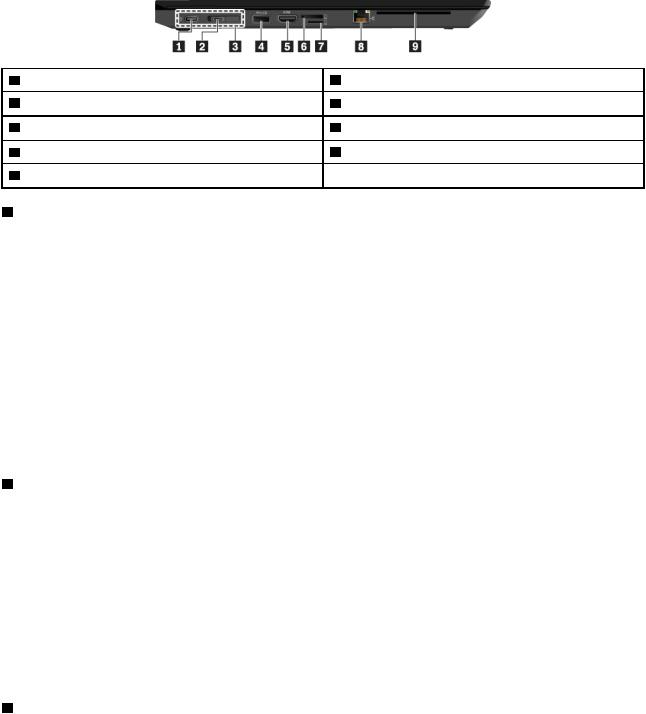
Left-side view
1 |
USB-C |
connector |
|
2 |
USB™-C connector |
3 |
Docking-station connector |
|
4 |
Always On USB 3.1 connector Gen 1 |
|
5 |
HDMI |
connector |
™ |
6 |
Nano-SIM-card tray |
7 |
microSD card slot |
|
8 |
Ethernet connector |
|
9 |
Smart-card slot (available on some models) |
|
|
|
|
1 USB-C connector
The USB-C connector / power connector on your computer supports the USB Type-C standard. With an appropriate USB-C cable connected, you can use the connector to transfer data (USB3.1 Gen 1: 5 Gbps), charge your device (5 V/ 3 A), or connect your computer to external displays (USB-C to VGA: 1900 x 1200 pixles /60 Hz; USB-C to DP: 3840 x 2160 pixels /60 Hz).
This USB-C connector also works as the power connector. Use the shipped USB-C power adapter and power cord to connect the computer to ac power through the USB-C connector.
Lenovo provides various USB-C accessories to help you expand your computer functionality. For more information, go to:
https://www.lenovo.com/accessories
Note: When the battery power is below 10%, the USB-C accessories connected to the USB-C connector might not work correctly.
2 USB-C connector
The USB-C connector on your computer supports the USB Type-C standard. With an appropriate USB-C cable connected, you can use the connector to transfer data (USB3.1 Gen 1: 5 Gbps), charge your device (5 V/ 3 A), or connect your computer to external displays (USB-C to VGA: 1900 x 1200 pixles /60 Hz; USB-C to DP: 3840 x 2160 pixels /60 Hz).
Lenovo provides various USB-C accessories to help you expand your computer functionality. For more information, go to:
https://www.lenovo.com/accessories
Note: When the battery power is below 10%, the USB-C accessories connected to the USB-C connector might not work correctly.
3 Docking-station connector
You can connect the computer to a supported docking station to extend the computer capabilities. For more information, see “Attaching your computer to a docking station” on page 45. Your computer supports the following docking stations that can be purchased as options from:
https://www.lenovo.com/accessories
•ThinkPad Basic Docking Station
•ThinkPad Pro Docking Station
Chapter 1. Product overview 5

• ThinkPad Ultra Docking Station
4 Always On USB 3.1 connector Gen 1
To charge the USB-compatible devices when your computer is off, in sleep mode, or in hibernation mode, enable the Always On USB feature on your computer.
To configure the Always On USB settings, do the following:
1. Start the Lenovo Vantage program. See “Accessing Lenovo programs” on page 16.
2. Click Hardware Settings Power |
. |
3.Locate the Always On USB section and follow the instructions on the screen to make your preferred setting.
Note: The Always On USB 3.1 connector Gen 1 does not work if you click Charge from Sleep and your computer is off without connecting to ac power.
5 High-Definition Multimedia Interface (HDMI) connector
The HDMI connector is a digital audio and video interface. It enables you to connect your computer to a compatible digital audio device or video monitor, such as an HDTV.
6 Nano-SIM-card tray
If your computer supports the wireless wide area network (wireless WAN) feature, a nano Subscriber Identity Module (SIM) card might be required to establish wireless-WAN connections. Depending on the country or region of delivery, the nano-SIM card might be already installed in the nano-SIM-card tray. For more information, see “Using the wireless-WAN connection” on page 33.
7 microSD card slot
You can insert a microSD card into the microSD card slot for data access or storage. For more information, see “Using a media card or a smart card” on page 38.
8 Ethernet connector
The Ethernet connector enables you to connect the computer to a local area network (LAN) (1 Gbps, 100 Mbps, 10 Mbps).
 DANGER
DANGER
To avoid the risk of electrical shock, do not connect the telephone cable to the Ethernet connector. You can only connect an Ethernet cable to this connector.
The Ethernet connector has two network status indicators. When the green indicator is on, the computer is connected to a LAN. When the yellow indicator blinks, data is being transmitted.
Note: If the computer is connected to a docking station, use the Ethernet connector on the docking station instead of the one on the computer.
9 Smart-card slot (available on some models)
You can use smart cards for authentication, data storage, and application processing. Within large organizations, you might also use smart cards for strong security authentication of single sign-on (SSO). For more information, see “Using a media card or a smart card” on page 38.
6 L480 and L580 User Guide

Right-side view
1 |
Audio connector |
2 |
USB 3.1 connector Gen 1 |
3 |
Fan louvers |
4 |
Security-lock slot |
1 Audio connector
You can connect headphones or a headset with a 3.5-mm (0.14-inch), 4-pole plug to the audio connector to listen to the sound from the computer.
If you are using a headset with a function switch, do not press this switch while using the headset. If you press the switch, the headset microphone is disabled, and the integrated microphones on the computer are enabled instead.
Note: The audio connector does not support a conventional microphone. For more information, see “Using audio features” on page 36.
2 USB 3.1 connector Gen 1
You can use the USB 3.1 connector Gen 1 to connect USB-compatible devices, such as a USB keyboard, USB mouse, USB storage device, or USB printer.
Attention: When you attach a USB cable to this connector, ensure that the USB mark is facing upward. Otherwise the connector might get damaged.
3 Fan louvers
The fan louvers and internal fan enable air to circulate in the computer to ensure proper cooling, especially the cooling of the microprocessor.
Note: To ensure proper airflow, do not place any obstacles in front of the fan louvers.
4 Security-lock slot
To protect your computer from theft, lock your computer to a desk, table, or other fixture through a security cable lock that fits this security-lock slot.
Note: You are responsible for evaluating, selecting, and implementing the locking device and security feature. Lenovo makes no comments, judgments, or warranties about the function, quality, or performance of the locking device and security feature.
Chapter 1. Product overview 7
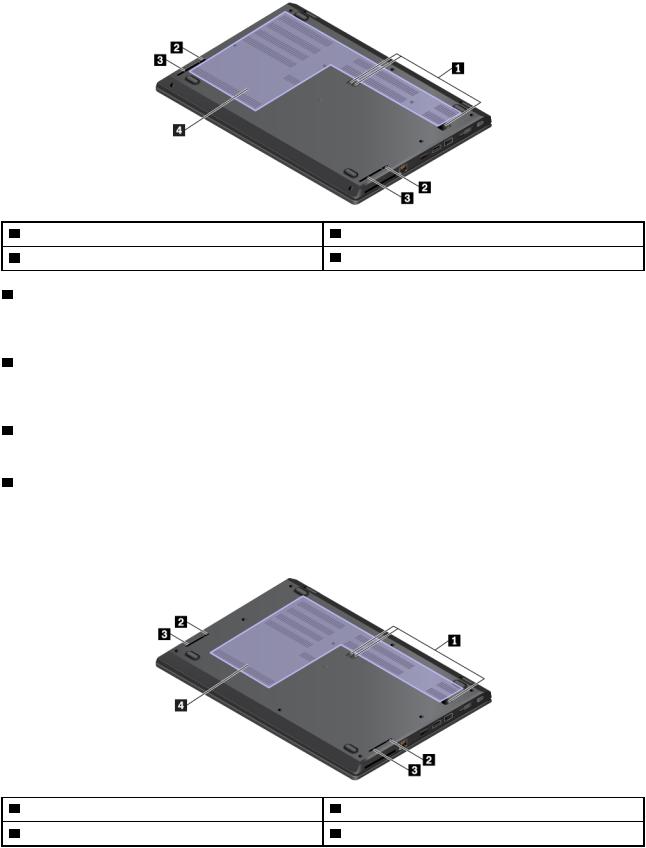
Bottom view (for ThinkPad L480 computers)
1 |
Docking-station hook holes |
2 |
Keyboard drainage holes |
3 |
Speakers |
4 |
Fan louvers |
1 Docking-station hook holes
You can use the docking-station positioning holes to secure a supported docking station to extend the computer capabilities.
2 Keyboard drainage holes
If you accidentally spill water or drink over the keyboard, the keyboard drainage holes can help drain out liquid from your computer.
3 Speakers
Your computer is equipped with a pair of stereo speakers.
4 Fan louvers
The fan louvers and internal fan enable air to circulate in the computer to ensure proper cooling, especially the cooling of the microprocessor.
Bottom view (for ThinkPad L580 computers)
1 |
Docking-station positioning holes |
2 |
Keyboard drainage holes |
3 |
Speakers |
4 |
Fan louvers |
8 L480 and L580 User Guide

1 Docking-station positioning holes
You can use the docking-station positioning holes to secure a supported docking station to extend the computer capabilities.
2 Keyboard drainage holes
If you accidentally spill water or drink over the keyboard, the keyboard drainage holes can help drain out liquid from your computer.
3 Speakers
Your computer is equipped with a pair of stereo speakers.
4 Fan louvers
The fan louvers and internal fan enable air to circulate in the computer to ensure proper cooling, especially the cooling of the microprocessor.
Status indicators (for ThinkPad L480 computers)
This topic provides information about locating and identifying the various status indicators on your computer.
Note: Depending on the model, your computer might look different from the following illustrations.
Chapter 1. Product overview 9

1 Caps Lock indicator
When this indicator is on, you can type uppercase letters by directly pressing the letter keys.
2 Fn Lock indicator
This indicator shows the status of Fn Lock function. For more information, see “Using the special keys (for ThinkPad L480 computers)” on page 22.
3 Speaker-mute indicator
When this indicator is on, the speakers are muted.
4 Microphone-mute indicator
When this indicator is on, the microphones are muted.
5 Camera status indicator
When this indicator is on, the camera is in use.
6 7 System status indicators
The indicator in the ThinkPad logo on the computer lid and the indicator in the power button show the system status of your computer.
• Blinks for three times The computer is initially connected to power. :
•On The computer is on (in normal: mode).
•Off The computer is off or in hibernation: mode.
• |
Blinks quickly The computer is entering sleep or hibernation mode. |
: |
• |
Blinks slowly The computer is in sleep mode. |
: |
8 |
ac power status indicator |
|
This indicator shows the ac power and battery power status of the computer. |
||
• |
White connected to ac power (battery power 90%–100%) : |
|
• |
Amber connected to ac power (battery power 0%–90%) |
: |
• |
Off not connected to ac power : |
|
Status indicators (for ThinkPad L580 computers)
This topic provides information about locating and identifying the various status indicators on your computer.
10 L480 and L580 User Guide

Note: Depending on the model, your computer might look different from the following illustrations.
1 Caps Lock indicator
When this indicator is on, you can type uppercase letters by directly pressing the letter keys.
2 Fn Lock indicator
This indicator shows the status of Fn Lock function. For more information, see “Using the special keys (for ThinkPad L480 computers)” on page 22.
3 Speaker-mute indicator
When this indicator is on, the speakers are muted.
4 Microphone-mute indicator
When this indicator is on, the microphones are muted.
5 Camera status indicator
When this indicator is on, the camera is in use.
6 Numeric Lock indicator
When this indicator is on, you can use the numeric keypad to type numbers.
Chapter 1. Product overview 11
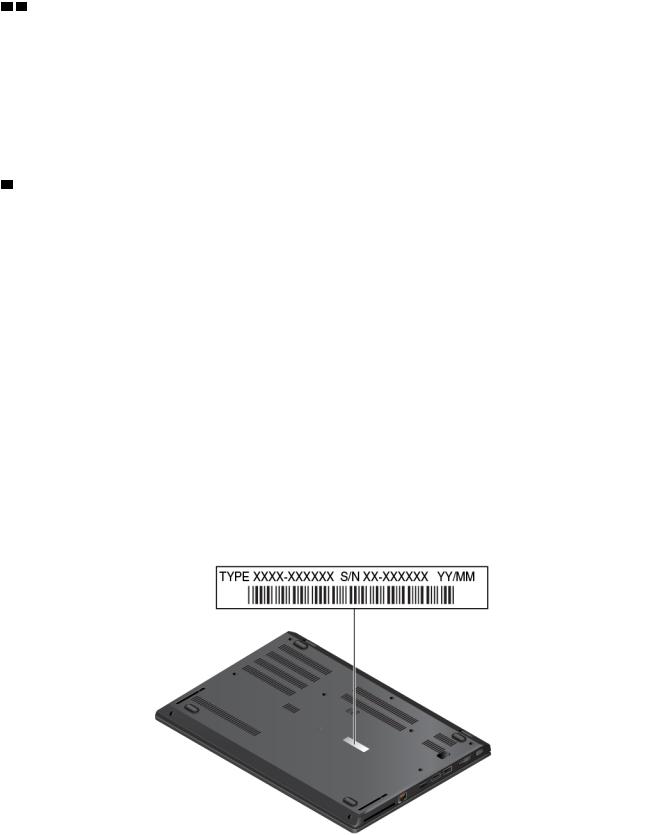
7 8 System status indicators
The indicator in the ThinkPad logo on the computer lid and the indicator in the power button show the system status of your computer.
• Blinks for three times The computer is initially connected to power. :
•On The computer is on (in normal: mode).
•Off The computer is off or in hibernation: mode.
• |
Blinks quickly The computer is entering sleep or hibernation mode. |
: |
• |
Blinks slowly The computer is in sleep mode. |
: |
9 |
ac power status indicator |
|
This indicator shows the ac power and battery power status of the computer. |
||
• |
White connected to ac power (battery power 90%–100%) : |
|
• |
Amber connected to ac power (battery power 0%–90%) |
: |
• |
Off not connected to ac power : |
|
Important product information
This section provides information to help you locate the following:
•Machine type and model information
•FCC ID and IC Certification information
•Windows operating systems information
Machine type and model information
When you contact Lenovo for help, the machine type and model information helps the technicians to identify your computer and provide faster service.
The following illustration shows where to find the machine type and model information of your computer.
For ThinkPad L480 computers:
12 L480 and L580 User Guide
